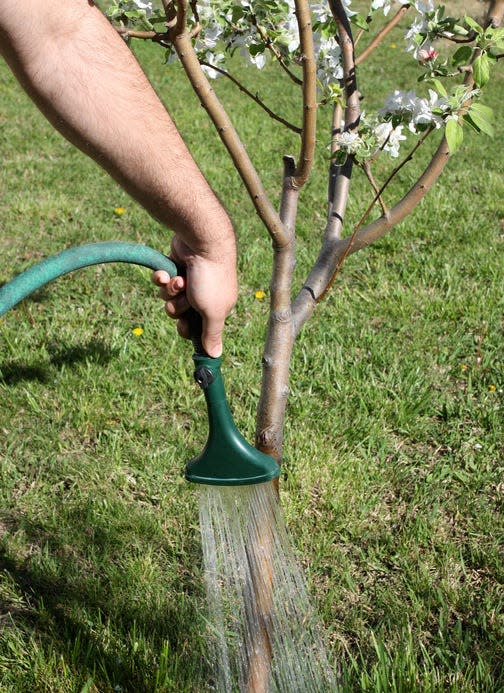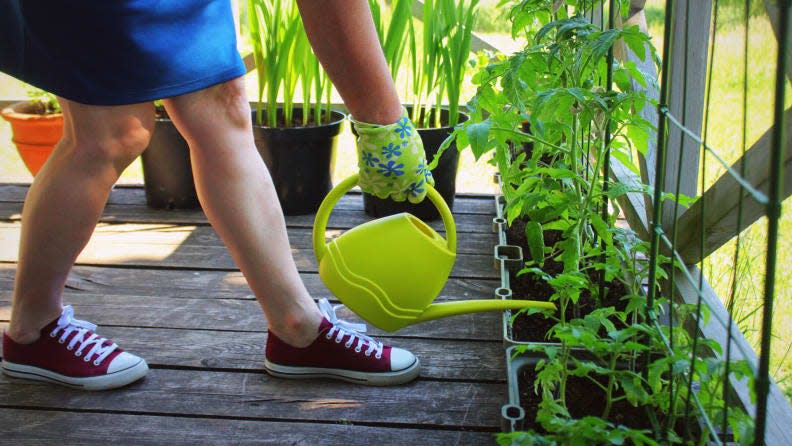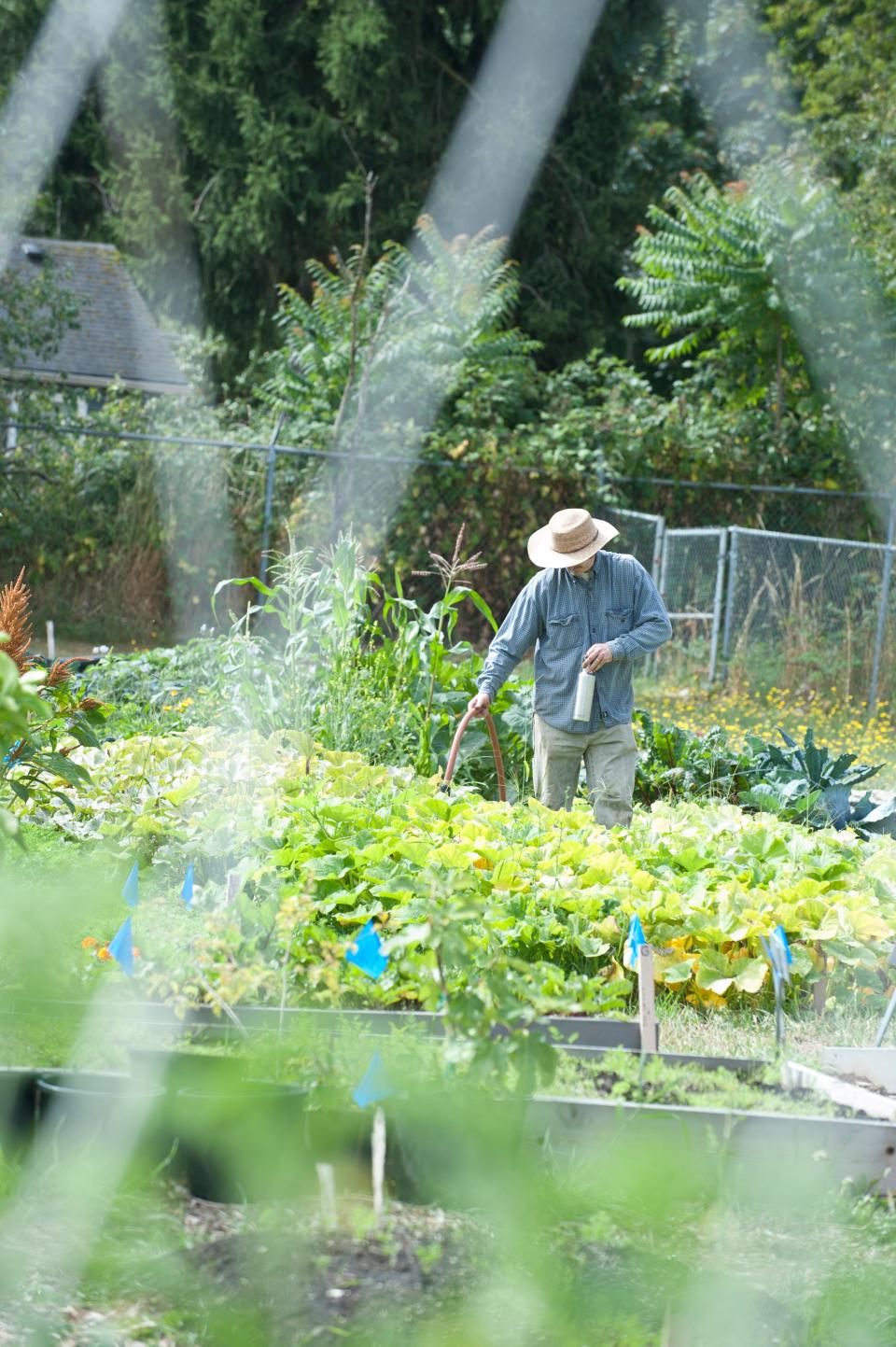Try these 5 tips for watering plants in your garden and home

Whether it's under the pressure of an approaching Kentucky Derby week, getting ready to head out of town for summer vacation, or the sheer embarrassment of having had plants in black plastic pots on the driveway for far too long, from time to time we all fall victim to the "I’m going out there right now to jam all those plants in the ground," gardening syndrome. And as much as experienced gardeners know better, it’s hard not to think of that planting as the end product of a process.
Of course, as we all know ― many of us from personal experience ― that planting isn’t the end product. It’s actually just the beginning.
Providing sufficient irrigation to help a plant navigate the re-establishment process can be difficult and confusing. If it rains overnight, no need for irrigation this morning, right? If the soil around the plant’s root ball is moist, skip a day, right? I just watered it yesterday so I’m good for today, correct?
Not necessarily.
The first consideration required to plan your irrigation needs is how the plant was produced. So here's what to know about how to care for your newly planted plants:
How often should I water field-grown plants?
Field-grown plants, most often sold balled and wrapped in burlap, are most often grown in field soil very high in mineral content. It likely has some organic matter added for fertility reasons but compared to a soilless, container mix, field soils are very, very fine textured. They hold lots and lots of water after they are well watered. They dry out much more slowly than a soilless mix and are also much harder to thoroughly irrigate.
You may like3 tips for planting flowers, vegetables and more this fall
The fine, mineral soil of most field operations (and in turn, the root ball of your newly planted plant) has tiny pore spaces ― the spaces that allow water to infiltrate and drain away. If the root ball is reasonably moist when planted, it won’t dry out in a day. Good irrigation at planting time and every third day should be fine. A fairly dry soil ball can take literally hours for your sprinkler-applied water to fully wet the whole affair. Best to not let them dry out in the first place.
How often should I water bare root plants?
Bare root plants are sold, just as the name implies, with no soil or potting mix surrounding the roots. You can buy just about anything in a bare root condition ― trees, shrubs, herbaceous perennials, asparagus, etc. The water absorbing, drainage and drying qualities of the soil, in this case, will depend on what kind of soil you have in your garden. Some wet, drain and dry easier or faster than others.
Generally, if you have a reasonable quality garden soil, bare root plants are fine with thorough irrigation at planting time and then every other day for a few weeks.
How often should I water container-grown plants?

Container grown plants are typically grown in what is known as soilless media. You're familiar with these mixes — they generally consist of various percentages of peat moss, composted bark, and a few other minor bits and pieces. But other than possibly some coarse sand (mostly to add weight and help keep plants standing upright in the nursery) there is generally no mineral soil present. These mixes drain very well which makes them perfect for container production. But their coarse texture means that they don’t hold much water after watering or a rain event.
You may likeSo, what is hardscape landscaping? Here are 3 hardscape ideas for your garden
When you plant a new container-grown plant, it takes almost no time at all to thoroughly wet the root and growing medium mass — 10 seconds can do the trick on smaller plants. The problem is, the faster it wets the faster it dries out. Remember that your container plant has been sitting in a nursery, sometimes receiving four or five waterings a day. When you drop it in the garden, it doesn’t magically turn into a plant that can get by with one watering every three days. Water in the surrounding mineral soil, no matter how well you’ve amended it with your magical compost, doesn’t move laterally into the root ball. You have to treat your plant, at least initially, just as it was treated in the nursery before you put it in the ground. Water every day until the roots begin to explore the surrounding soil.
How do I encourage root mass growth in newly-planted plants?

Regardless of the type of plant you’ve planted — field-grown, container-grown or bare root — you want to keep the root mass you installed, as well as the surrounding soil, sufficiently moist to encourage new root growth. And the only way to do that is to get your knees dirty. Literally rolling up your sleeves and sticking your fingers in the ground is the only way to know what’s going on below ground.
For an aggressive growing, bare root daylily planted in May, that might mean daily watering for a week followed by every three days for a few weeks and then leaving it to its own devices for the rest of the summer. For a container-grown maple, you might be looking at more like daily watering for a month or more and then at least weekly for the rest of the summer ... maybe even the next summer as well.
How often should I water my plants after it rains?
Finally, there’s the issue of rain — and here’s the best way to work rain into your new plant watering schedule.
First, any rain of less than an hour doesn’t count. Honestly. Even if it’s one of those 1-inch downpours that come in 15 minutes, most of that water ends up in the creek or storm sewer.
You may likeFrom potting soil to mixed planting, 5 tips to get the most out of your container plants
Second, and this is the really important one, don’t tempt the rain gods by skipping a morning watering because there’s a 90% chance of heavy rain later in the day. Really. For the benefit of all of us, just don't do it. The garden gods do not have a sense of humor.
Now if you’ll excuse me, I have to run out and jam a few plants in the ground before heading to the airport.
Paul Cappiello is the executive director at Yew Dell Botanical Gardens, 6220 Old Lagrange Road, yewdellgardens.org.
This article originally appeared on Louisville Courier Journal: Tips for watering plants in your garden and inside your home

